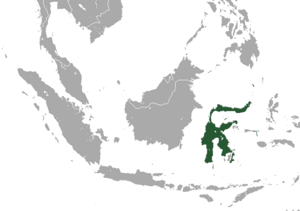Sulawesi flying fox facts for kids
Quick facts for kids Sulawesi flying fox |
|
|---|---|
 |
|
| Conservation status | |
| Scientific classification | |
| Genus: |
Acerodon
|
| Species: |
celebensis
|
 |
|
| Sulawesi flying fox range | |
| Synonyms | |
|
Acerodon arquatus |
|
The Sulawesi flying fox is also known as the Sulawesi fruit bat. Its scientific name is Acerodon celebensis. This amazing animal is a type of megabat, which means it's a very large bat. It only lives in Indonesia, making it an endemic species. Sadly, it is considered "Vulnerable" by the IUCN because too many are being hunted.
Contents
Where Do They Live?
The Sulawesi flying fox lives only on the island of Sulawesi in Indonesia. You can also find them on some smaller nearby islands. These include Buton, Mangole, Sanana, Siau, Sangihe, and Selayar. They like to live in low-lying areas, usually below 1,500 meters (about 4,900 feet) above sea level.
What Do They Eat?
Sulawesi flying foxes are frugivores, which means they mostly eat fruit. Their favorite foods include coconuts and breadfruits. They also love the pollen and nectar from eucalyptus flowers. However, if these are hard to find, they will eat other fruits that grow in Sulawesi.
These bats are super important for the environment! They help plants grow by spreading pollen and seeds. When they eat fruit, they drop seeds or spread them through their waste. They can carry pollen on their fur over long distances. This helps plants that need pollen from other plants to make new seeds. Food moves through their bodies quite quickly, taking only about 12 to 34 minutes.
How Do They Live?
Sulawesi flying foxes usually rest in trees during the day. They often choose trees in mangrove forests. They don't like to be disturbed by people. Sometimes, they share their resting spots with other bats, like the black flying fox. The Sulawesi flying foxes prefer to stay on the higher branches.
These bats live in groups called colonies or camps. Some camps are always in the same spot, while others are only used for a certain time of year. Camps are usually in protected areas with tall, dense trees and close to water. The size of a camp depends on how much food is available nearby. Camps are vital for these bats to learn how to survive and form relationships.
Sulawesi flying foxes are nocturnal, meaning they are active at night. They fly out to find food when it's dark. At dawn, they return to their camp or find another camp to rest and socialize. To drink water, they fly quickly over the water, just brushing their bellies. Then, they fly to a tree and lick the water droplets off their fur.
Life Cycle and Reproduction
Sulawesi flying foxes reproduce slowly. Their mating season is usually between March and May. A male bat will find a tree and claim it as his territory. He will make loud noises to warn other males to stay away. This is the noisiest time in the camp! Males also release special scents from glands on their shoulders to attract females.
Females choose their mates. They often pick the male with the strongest smell who is highest in a tree. After mating, the female carries her baby, called a pup, for about six months. Pups are usually born in October or November. Most often, a female will have only one pup per year.
When a pup is born, it immediately starts drinking its mother's milk. Baby bats have special curved teeth that help them hold onto their mother's nipple very tightly. The mother carries her pup with her when she flies out to find food at night. The pup holds onto her nipple and her waist with its feet. This lasts for about five weeks, or until the pup gets too heavy.
After that, the mother leaves the pup in a tree near the camp while she goes to find food. This continues for another three to five weeks. The pup learns to fly and find its own food when it's about eight to ten weeks old. Females can start having babies when they are about 15 months old. Males take longer, maturing around three years of age.
Why Are They in Danger?
The Sulawesi flying fox is classified as a Vulnerable species. This means their numbers are decreasing, and they are at risk of becoming endangered. The main reason for this decline is too much hunting by local people. They are hunted for food for their families and to be sold.
The places where these bats rest during the day are often heavily hunted. There isn't enough official protection for these areas, so the trees where they roost might even be cut down. Because of overhunting, the Sulawesi flying fox has already disappeared from some parts of North Sulawesi.


